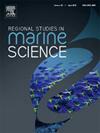A seal’s tale: de novo colonization of an intertidal sandbar in a highly anthropized harbor by the Harbor and Grey seals
IF 2.1
4区 环境科学与生态学
Q3 ECOLOGY
引用次数: 0
Abstract
In the eastern English Channel, both harbor (Phoca vitulina) and grey seals (Halichoerus grypus) faced near extinction in the late 19th and early 20th centuries due to hunting and perceptions of their detrimental impact on local fisheries. Conservation efforts, including a 1972 hunting ban and reinforced management strategies, led to the recovery of these species, particularly in sheltered bays and estuaries. Despite the sensitivity of these species to anthropogenic disturbances, since 2010 P. vitulina and H. grypus have increasingly been observed hauling out on a tidal sandbar in Boulogne-sur-Mer harbor, a site heavily impacted by agricultural, urban and industrial runoffs, as well as fishing, shipping and recreative boating. Seal presence was opportunistically recorded on this haul-out site from January 2014 to December 2023. P. vitulina was consistently observed from 2016. H. grypus were rare until 2017, and subsequently increased with a clear seasonality, i.e. more abundant during the summer and absent from November to February. Trends in maximum haul-out numbers showed a significant linear increase at a rate of nearly 5 % per year from 2014 to 2020 before reaching a steady state from 2020 to 2023. In contrast, H. grypus maximum abundances increased exponentially at a yearly rate of 37 % over the course of our survey. These results suggest that the sandbars within Boulogne-sur-Mer harbor may hold exceptional patrimonial value, despite significant anthropogenic disturbances. They also warrant the need for further studies to understand the consequences of anthropogenic disturbances on the conservation and management of seal populations.
求助全文
约1分钟内获得全文
求助全文
来源期刊

Regional Studies in Marine Science
Agricultural and Biological Sciences-Ecology, Evolution, Behavior and Systematics
CiteScore
3.90
自引率
4.80%
发文量
336
审稿时长
69 days
期刊介绍:
REGIONAL STUDIES IN MARINE SCIENCE will publish scientifically sound papers on regional aspects of maritime and marine resources in estuaries, coastal zones, continental shelf, the seas and oceans.
 求助内容:
求助内容: 应助结果提醒方式:
应助结果提醒方式:


